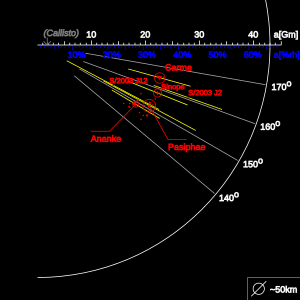| Discovery | |
|---|---|
| Discovered by | S. B. Nicholson |
| Discovery date | September 28, 1951 |
| Periapsis | 12,567,000 km |
| Apoapsis | 29,063,500 km |
| Mean orbit radius | 21,280,000 km[1] |
| Eccentricity | 0.24[1] |
| Orbital period | 610.45 d (1.680 a)[1] |
| Average orbital speed | 2.367 km/s |
| Inclination | 148.89° (to the ecliptic) 149.9° (to Jupiter's equator)[1] |
| Satellite of | Jupiter |
| Physical characteristics | |
| Mean radius | 14 km[2] |
| Surface area | ~2500 km² |
| Volume | ~11,500 km³ |
| Mass | 3.0 × 1016 kg |
| Mean density | 2.6 g/cm³ (assumed) |
| Equatorial surface gravity | 0.010 m/s2 (0.001 g) |
| Escape velocity | ~0.017 km/s |
| Albedo | 0.04 (assumed)[2] |
| Temperature | ~124 K |
| | |
Ananke (pronounced /əˈnæŋki/ ə-NANG-kee, or as in Greek Ανάγκη) is a retrograde irregular satellite of Jupiter. It was discovered by Seth Barnes Nicholson at Mount Wilson Observatory in 1951[3] and is named after the mythological Ananke, the mother of Adrastea by Jupiter. The adjectival form of the name is Anankean.
Ananke did not receive its present name[4] until 1975;[5] before then, it was simply known as Jupiter XII. It was sometimes called "Adrastea"[6] between 1955 and 1975. Note that Adrastea is now the name of another satellite of Jupiter.
Ananke gives its name to the Ananke group, retrograde irregular moons which orbit Jupiter between 19.3 and 22.7 Gm, at inclinations of roughly 150°.[2]
| |
Orbit
Ananke orbits Jupiter on a high eccentricity and high inclination retrograde orbit. Eight irregular satellites discovered since 2000 follow similar orbits.[2] The orbital elements are as of January 2000.[1] They are continuously changing due to Solar and planetary perturbations. The diagram illustrates Ananke's orbit in relation to other retrograde irregular satellites of Jupiter. The eccentricity of selected orbits is represented by the yellow segments (extending from the pericentre to the apocentre). The outermost regular satellite Callisto is located for reference.
Given these orbital elements and the physical characteristics known so far, Ananke is thought to be the largest remnant[7] of an original break-up forming the Ananke group.[8][9]
Physical characteristics
In the visible spectrum, Ananke appears neutral to light-red (colour indices B-V=0.90 V-R=0.38).[9]
The infrared spectrum is similar to P-type asteroids but with a possible indication of water.[10]

0 comments:
Post a Comment